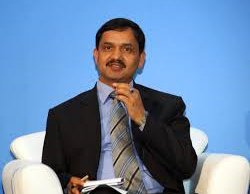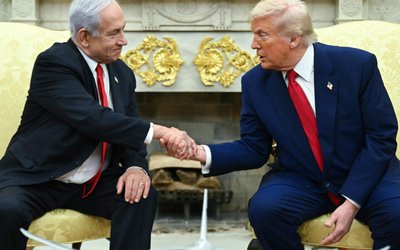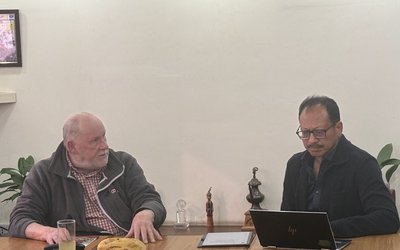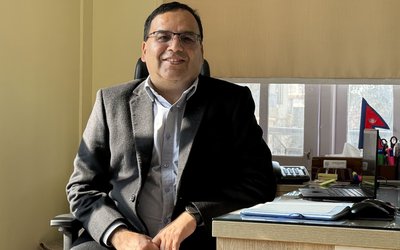
A renowned expert on renewable energy, Professor Govinda Raj Pokharel, executive director of Alternative Energy Promotion Center (AEPC), has worked in the energy sector for a long time. As Nepal has been witnessing serious phases of power crisis, Dr. Pokharel, with a lot of experience to his credit, spoke to New Spotlight on the issues related to alternative energy promotion in Nepal. Excerpts:
How do you see the present state of the use of alternative energy in Nepal?
Nepal is a country endowed with a high potential for renewable energy resources like hydro, solar, wind and biomass, etc. The country has abundant hydroelectric potential. However, we are not able to fully convert it into useful energy. The use of alternative/renewable energy technologies is growing. Presently around 14% of the population is benefiting from the electricity generated by the alternative energy sources like micro hydro plants and solar home systems. Around 900 thousand households are using clean energy solutions like improved cook stoves and biogas etc. for cooking. Although the share of alternative energy sources is still small, it has increased by more than 50% since 2005 and this trend is expected to grow in the future also. Because of Alternative Energy Technologies, many social issues like regional disparity in access to clean energy, indoor air pollution and employment generation, reduced pressure on forest are positively addressed.
What message does the center want to give by organizing Renewable Energy Week 2014?
AEPC is celebrating “Renewable Energy Week 2014” from 6 -10 February 2013 in Kathmandu Valley and at the district level. The theme of this year’s RE Week is “Renewable Energy for green industrial development”. Therefore, AEPC is partnering with Federation of Nepali Cottage and Small Industries (FNCSI) to organize this event.
The objectives of the event are to
· create awareness about large scale utilization of renewable energy to general public for wider use in Nepal and to address present energy crisis,
· sensitise policy makers to make Renewable Energy as the mainstream energy source for economic development,
· attract and engage private sector investment in renewable energy sector.
Why is renewable energy important for a country like Nepal. Is it more affordable to the poor?
Renewable energy is very important for a country like Nepal. There are several reasons. Renewable energy is only one viable means in Nepal to increase the access of energy to its population. As you know, Nepal has diversified land structure from plains to high Himalayas and also settlement patterns are scattered and sparse. National grid extension in some places is not economically feasible. Big hydro projects need a huge investment and all the petroleum products consumed in Nepal are imported from India or overseas in the refined form for direct consumption, which is causing the economic burden for the country.
The high potentiality of the renewable energy resources available in the country is the most appropriate option for Nepal. It also helps to reduce the dependency on the traditional biomass energy resources and fossil fuels and to manage the energy crisis of the nation. This ultimately helps to minimize the degradation of the environment. Besides, decentralized renewable energy solutions are perfectly addressing the issues of energy development disparity regionally and socially.
More importantly, to enhance energy security, we need to go for energy mix, i.e. energy from different sources, i.e. hydro power, solar, wind, biomass etc. From this perspective, renewable energy is very important for the country.
How has Alternative Energy Promotion Center been working to promote renewable energy in Nepal?
Alternative Energy Promotion Centre is a national focal organization for promoting renewable and alternative energy technologies in Nepal. Since its establishment in 1996, AEPC’s main focus has been to maximize the service delivery efficiency in the use of renewable energy resources and technologies in the rural areas and to provide opportunity to low-income rural households to use RETs. AEPC adopts public private partnership approach. We promote technology based on demands. Subsidy provided by the government is helping to create the demands.
AEPC is acting as an intermediary institution between the operational level i.e. NGOs/private promoters of renewable energy and the policy decision levels in relevant ministries. AEPC mainly focuses on renewable energy policy formulation, planning and facilitating the implementation of the policies/plans, standardization, quality control and monitoring.
Given Nepal’s current power crisis, how can alternative energy support to address it?
In Nepal majority of people including policy makers consider renewable energy technologies as alternative energy that is only useful to provide energy in rural and remote areas. But in reality renewable energy technologies have the potential to be the mainstreaming energy. For example, 40KWp solar PV system installed in our AEPC building is powering all equipment and we are now not affected by load shedding. Likewise urban biogas promoted by AEPC can replace 4 cylinders of LPG every year.
Recently government of Nepal has come up with a program to provide incentives to install 100 w more than 100 watt peak solar PV system in urban areas. Households will be provided with incentives of Rs 5000 for 100-200 watt; and Rs 8000 for more than 200 watt. This will help to reduce load shedding effects on users. Initially this program will be implemented in 14 municipalities.
There is a need of proper policies like net metering, feed in tariff, tax rebate etc. which will encourage use of renewable energy technologies even in urban areas. There is no doubt that to enhance energy security in the country, it is most urgent to have energy mix with multiple energy resources. We need to rationally utilize all our abundant renewable resources such as hydro, solar, biogas, wind etc.
What is the contribution of alternative energy in Nepal’s overall power generation?
The contribution of alternative energy in Nepal’s overall power generation is about 1% and its share is growing but more than 14% people are using light from RE and 25% households in Nepal are using either one or other RE technology.
As there are several sources of alternative energy, which do you think are preferable to Nepal?
Nepal is blessed with all types of renewable energy sources like hydro, solar, biomass and wind. It is difficult to say which technology is preferable because it depends upon availability of resources. In areas where there are water sources, it is feasible to develop mini/micro hydro than in such locations where mini/micro hydro cannot be suitable options. In areas where mini/micro hydro is not feasible but there is enough solar radiation, solar energy can be a suitable option. But mini/micro hydro cannot be compared with biogas or improved cook stoves. The earlier two are mainly used for electrification whereas the latter two are used for cooking.
We have also bio-ethanol that can reduce the consumption of petrol that is imported, similarly bio-diesel can also be promoted to reduce consumption of diesel. So we have many types of renewable sources. However, it depends on which end-uses i.e. cooking fuel, transportation fuel/energy or electrical energy, to define preferable sources of energy. In the Nepalese context, hydropower is the backbone of our electrical energy supplying source, then comes solar, biomass, wind and other sources.
What is the state of solar energy? A question about the quality of solar panel is often raised. How do you look at it?
The use of solar PV system is growing as a trend. More than 400 thousand solar home systems have been installed in rural areas without grid connection. Due to load shedding use of solar PV is also increasing in urban areas.
The question regarding the quality of solar system has been raised mainly because we are not able to properly communicate to people on quality control systems adopted by AEPC. AEPC’s main role is to maintain the quality of the renewable energy technologies promoted under subsidy program. We provide subsidy to users through the qualified companies (Vendors) only. The qualified companies create demand; install systems that comply with Nepal Photovoltaic Quality Assurance (NEPQA). There is Renewable Energy Test Station (RETS) under Nepal Academy of Science and Technology (NAST) that carries out detailed tests of solar home system components. Solar companies come up with the project completion report which is reviewed by our own team in AEPC. Only those eligible for subsidy are recommended for subsidy. Only a 90% of the subsidy amount is paid after installation and the remaining 10% is paid after one year of satisfactory performance of the system. If the company is found to be taking subsidy without installation, we have a strong penalty mechanism, including disqualification.
Another interesting fact is that solar sector consumes only 13% of battery consumed in Nepal, the rest are consumed by automobile and other sectors. But only batteries used in solar sector are tested in Nepal. In addition to that, AEPC is coming up with waste battery management and collection centres. Nepal will have soon old battery management and collection centre to avoid hazardous effects of old batteries.
What is the state of micro-hydro, solar and bio-gas?
Till date under AEPC programs around 25 MW micro hydro projects have been established and these projects have electrified around 200 thousand rural households. Similarly, more than 400 thousand rural households have been electrified by solar home systems and around 300 thousand households are using domestic biogas technology that uses animal dung as feed stock for cooking. More than 8000 Improved Water Mills (improved Ghatta) are also being used by rural people for lighting, agriculture processing etc.
How do you look at the contributions from Nepal’s development partners?
Development partners are very positive and supportive in promoting renewable energy technologies in Nepal. AEPC is currently working in partnership with Danish government, Norwegian government, Kfw, ADB, the WB, EU, UNDP, UNCDF, UNSCAP, GIZ, SNV and other development partners and INGOs and NGOs. With their financial and technical support, AEPC is implementing a 5-year National Rural and Renewable Energy Programme (NRREP). This is a single framework programme that allows government to collaborate with many development partners willing to promote renewable energy technologies in Nepal. We also would like to request other development agencies to join hands with AEPC.
What are the challenges before the Center?
The challenges before AEPC are lack of suitable policies appropriate for the promotion of large scale RE at present situation, lack of coordination between relevant stakeholders and ownership, inadequate knowledge among decision makers about private sector led demand based approach that AEPC is adopting, lack of intensive engagement of financial sectors, difficult & inequitable access to finance and credit, difficult terrain, and inadequately trained human resource etc.
- MELAMCHI WATER SUPPLY: No Interruption During Monsoon
- Jun 25, 2025
- KOREAN RETURNEES: Successful Integration
- Jun 25, 2025
- UPPER TRISHULI-1: Engaging With Local
- Jun 25, 2025
- IME GROUP: Twenty Five Years Of Journey
- Jun 24, 2025
- NEPAL’S AIR POLLUTION: A Growing Health Concern
- Jun 24, 2025















